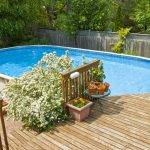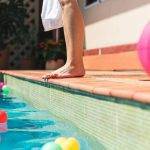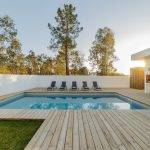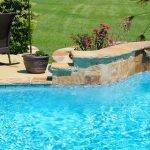Overview
A salt water chlorine generator (SWG) uses electricity to convert salt into chlorine. As the chlorine gets used up, it turns back into salt, ready to be reused. With a SWG, you are still using chlorine, the SWG simply takes care of adding the chlorine for you.
The salt levels used vary somewhat between models, commonly they are around 3,000 ppm. These levels are far lower than ocean water, which is around 35,000 ppm. Most people will be just barely able to taste the salt. In addition to allowing the SWG to work, adding salt also improves the subjective feel of the water.
SWGs are designed to produce small amounts of chlorine continuously. This is perfect for day to day use and actually allows you to use a slightly lower FC levels than you need when adding chlorine manually.
Adding salt to the pool does very slightly increase the risk of corrosion. Hardly any SWG owners experience a problem with corrosion. Because the exact risks for some of the materials used in pools are not well understood, there has been some debate in the industry about the use of SWGs.
The two most common situations where damage has occurred are in indoor pools, where the FC level has been allowed to get way too high, and when you have one of the softer kinds of natural stone (sandstone, limestone, etc) above the water line, and the stone gets splashed regularly, for example in a waterfall. Even in these two situations, problems are rare.
Pros (vs bleach)
- Convenience – no carrying bottles of bleach
- Missing a day isn’t a problem
- Less likely to have problems which require SLAMing the pool
- Improved water feel (from salt, which can be used without a SWG)
Cons (vs bleach)
- Most of the cost is paid up front to buy the unit
- It is more difficult to SLAM the pool due to the higher CYA level
- In rare cases you may need to run the pump longer, or at a higher speed, to produce enough chlorine
- A (very) few people object to the taste of salt in the water
Water Balance
For advice on how to best maintain your pools chemical balance for use with a SWG see Water Balance for SWGs.
Setting the Percentage
Most SWGs provide a percentage setting that controls how much chlorine they produce. This setting controls the percentage, of the time that the pump is running, during which the SWG is producing chlorine. To produce more chlorine you increase the percentage, to produce less chlorine you lower the percentage. Because the setting is a percentage of the pump run time, you will need to readjust the percentage if you change the pump run time. In rare cases, you may need to increase the pump run time to be able to produce enough chlorine.
To determine the correct SWG percentage setting:
- Determine the appropriate FC level for your CYA level. This can be found in the “SWG Pools” table in the Chlorine/CYA Chart.
- Measure the pools FC level in the early evening and compare that to the appropriate SWG FC level for your CYA level.
- If the actual FC level is too low, increase the percentage. If the actual FC level is too high, decrease the percentage.
- If you needed to make an adjustment, wait a couple of days and then go back to step 2 and repeat the steps from there until your FC level is in the correct range.
Chlorine demand will vary with the seasons and based on how many people are swimming in the pool. You should test your FC level weekly to see if you need to adjust the percentage setting. As you gain more familiarity with your pool, it may be possible to test a bit less often. Extremely hot weather, pool parties, and major storms may require that you manually add some chlorine to supplement the chlorine produced by the SWG.
Solving Problems
If the FC level falls to zero, even though the SWG appears to be working, there are a couple of things to check. First, verify the CYA level. If your CYA level has gotten too low, the SWG may not be able to keep up. Second, you may have algae. A pool with a SWG can have algae even when the water is relatively clear. Third, there may be some problem with the SWG, though this is much less likely than the first two possibilities.
SWGs are not good at SLAMing (or shocking) the pool because SLAMing depends on the FC level going up quickly and a SWG only adds chlorine slowly. If you are SLAMing the pool you should add chlorine manually. A SWG can be used to help maintain the FC level during SLAMing, but the initial addition of chlorine to shock level should always be done manually.
Maintenance
The SWG cell should be visually examined once per season or if you think there might be a problem. The cell should be clear of debris and the plates should appear either black or metallic.
If some of the plates have a white crusty or flaky buildup, the cell should be cleaned according to the directions that came with your SWG. Cleaning typically involves soaking the cell in a dilute muriatic acid solution. A white buildup on the cell plates, or thin white flakes of calcium getting into the pool, indicate a water balance problem which needs to be corrected to avoid ongoing problems.
The SWG cell should last around three to five years. The cell lifetime will vary depending on how much you use it and how well you maintain the water balance. In almost all models, the cell can be replaced when it wears out, without replacing the entire unit.





